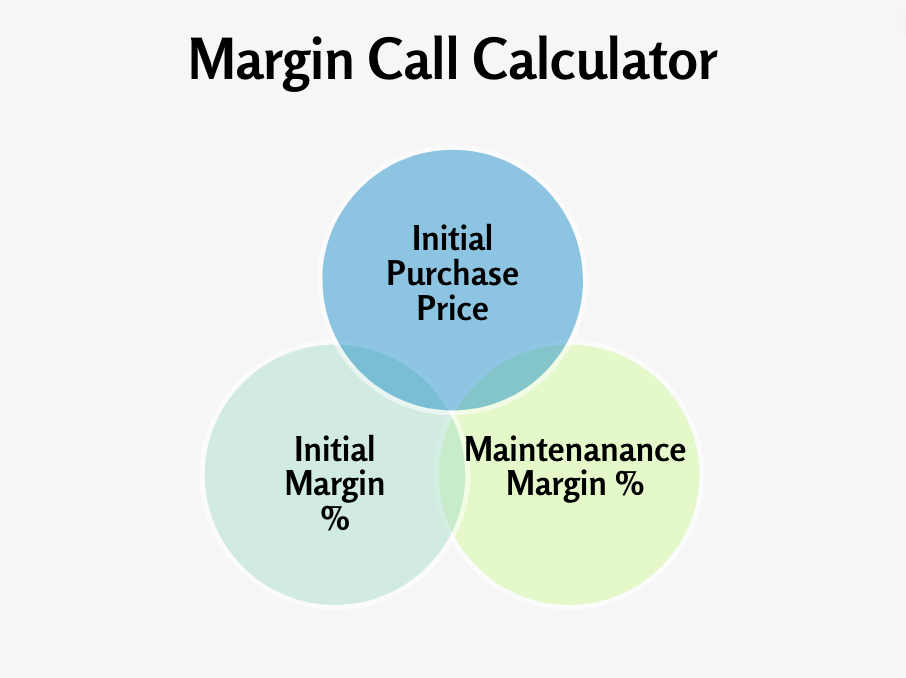A margin call calculator is a tool that traders and investors use to find out at what price their asset will receive a margin call when leverage trading forex, stocks, or crypto. Our calculator is simple to use as there are only three inputs, initial purchase price, initial margin %, and maintenance margin %.
Margin Call Price
Information: Ensure the Maintenance Margin is lower than the Initial Margin. Use this calculator to determine your Margin Call Price.
How to use the margin call calculator:
- Add your initial purchase price (eg. 30, 250, or 6500)
- Input your initial margin % (typically between 20-50%)
- Add your maintenance margin % (you can find this on your broker's website)
- Click calculate!
What to do with the result?
There are 5 ways that a margin calculator can help you in your trading:
- Check your margin levels: Check if your current margin level is above the required maintenance margin level. If yes, then no action is required.
- Decide if you need to top up margin: If you fall below the required maintenance margin requirement you need to add more margin to keep the position open.
- Reduce exposure: If your calculation shows that your margin level is too low you might need to reduce your exposure and close out parts of your leverage position to get back to a safe level.
- Test if your position is within risk limits: It is a great risk management technique with leverage to analyze whether the position you want to open is within your risk limits. This is best done before you open the position.
- Plan your strategy: Use your result to see if your strategy is high risk or low risk. Predetermine your risk reward ratio using a risk reward ratio calculator.
What is a margin call calculator?

A margin call price calculator is a tool used by traders to see at what price a margin call will be signaled from your broker.
Your margin is the trading capital, or collateral, that you deposit into your trading account.
By using a calculator to track margin calls you can know beforehand at what price you will expect a margin call from your broker.
The margin call calculator takes into account your initial purchase price, initial margin percentage, and your maintenance margin percentage.
With these inputs, the calculator calculates the margin call price of the position you want to open.
In a nutshell, the margin call calculator is a way of keeping track of the overall health of your trade size when leverage trading.
How to calculate margin call price
To calculate the margin call price of an asset or a position you first need to understand the concept of "maintenance margin" and the formula for calculating it.
Maintenance margin means the amount of margin capital that is required to keep a position open to avoid a margin call.
Maintenance margin = (Total Position Value) * (Maintenance Margin Requirement)
For example, your leverage stock trading platform might ask you to keep a minimum of 30% of your capital as maintenance margin if your open positions.
To calculate a margin call for any position, follow these steps:
- Determine the total position size: Multiply the current asset price by the number of shares you want to buy and the leverage ratio you want to use.
- Total Position Value = (Number of Units or Shares) * (Current Market Price)
- Calculate the maintenance margin: Multiply the total position size and the maintenance margin required by your broker.
- Maintenance Margin = (Total Position Value) * (Maintenance Margin Requirement)
- Calculate the margin call price: To get the margin call price, subtract the maintenance margin from the total position value and then divide that result by the number of units in your position.
- Margin Call Price = (Total Position Value - Maintenance Margin) / (Number of Units or Shares)
Our formula
The margin call formula calculates the price at which the margin call will get triggered.
The formula to calculate a margin call is:
Margin call = initial purchase price * [(1- initial margin)/ (1-maintenance margin)]
- Initial purchase price = The current price of the asset
- Initial margin = The amount of your own collateral that goes into the position
- Maintenance margin = The minimum required margin required by your broker
A calculation example
Let's use the given formula to calculate the margin call level for an example trade. The formula is:
Margin Call = Initial Purchase Price * [(1 - Initial Margin) / (1 - Maintenance Margin)]
We are going to assume that you want to buy 100 shares of a stock at an initial purchase price of $50 per share. The broker's initial margin requirement is 50%, and the maintenance margin requirement is 25%. Let's calculate the margin call level:
Step 1: Calculate the Initial Margin:
Initial Margin = Initial Purchase Price * Number of Shares * Initial Margin Requirement
Initial Margin = $50 * 100 * 0.50
Initial Margin = $2,500
Step 2: Calculate the Maintenance Margin:
Maintenance Margin = Initial Purchase Price * Number of Shares * Maintenance Margin Requirement
Maintenance Margin = $50 * 100 * 0.25
Maintenance Margin = $1,250
Step 3: Calculate the actual Level:
Margin Call = Initial Purchase Price * [(1 - Initial Margin) / (1 - Maintenance Margin)]
Margin Call = $50 * [(1 - $2,500) / (1 - $1,250)]
Margin Call = $50 * [(-$1,500) / (-$250)]
Margin Call = $50 * 6
Margin Call Level = $300
In this example, the margin call level is $300. If the stock's value drops to a point where your equity in the trade falls below $300, a margin call will be triggered, and you will need to add funds or close part of the position to meet the maintenance margin requirement.

